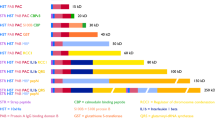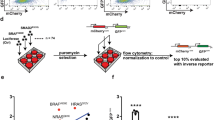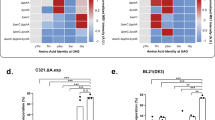Abstract
We have previously shown that transformed mammalian cells secrete two classes of transformation-specific proteins of molecular weight (MW) about 60,000 (ref. 1). Secretion of both classes of proteins occurs regardless of the transforming agent and is temperature-sensitive in a cell line which is temperature-sensitive for the transformed phenotype (ts B77 Rat 1; see ref. 1). One of the classes consists of non-phosphorylated polypeptides. The proteins of this class, derived from transformed mouse, rat and hamster lines, are all antigenically related to one another. The second class of transformation-specific secreted proteins is antigenically distinct from the first class, that is, it is not precipitated by antiserum which recognizes the non-phosphorylated class. This second class comprises major phosphoproteins also in the 60,000 M W range1. These major phosphoproteins were found to be secreted by transformed hamster, rat, mouse and rabbit cells. We now report that these transformation-specific phosphoproteins are all antigenically related, regardless of the transforming agent. The phosphoproteins are synthesized by the cells, phosphorylated intracellularly and subsequently released into the culture medium. These transformed cells also secrete protein kinase activities capable of phosphorylating the transformation-specific phosphoproteins in vitro. The major sites of in vivo and in vitro phosphorylation seem to be identical.
This is a preview of subscription content, access via your institution
Access options
Subscribe to this journal
Receive 51 print issues and online access
$199.00 per year
only $3.90 per issue
Buy this article
- Purchase on Springer Link
- Instant access to full article PDF
Prices may be subject to local taxes which are calculated during checkout
Similar content being viewed by others
References
Senger, D. R., Wirth, D. F. & Hynes, R. O. Cell 16, 885–893 (1979).
Hauschka, P. Meth. Cell Biol. 7, 361–462 (1973).
Purchio, A. F., Erikson, E., Brugge, J. S. & Erikson, R. L. Proc. natn. Acad. Sci. U.S.A. 75, 1567–1571 (1978).
Levinson, A. D., Oppermann, H., Levintow, L., Varmus, H. & Bishop, J. Cell 15, 561–572 (1978).
Oppermann, J., Levinson, A. C., Varmus, H. E., Levintow, L. & Bishop, J. M. Proc. natn. Acad. Sci. U.S.A. 76, 1804–1808 (1979).
Collett, M. S. & Erikson, R. L. Proc. natn. Acad. Sci. U.S.A. 75, 2021–2024 (1978).
Collett, M. S., Erikson, E., Purchio, A. F., Brugge, J. S. & Erikson, R. L. Proc. natn. Acad. Sci. U.S.A. 76, 3159–3163 (1979).
Laemmli, U. K. Nature 227, 680–685 (1970).
Author information
Authors and Affiliations
Rights and permissions
About this article
Cite this article
Senger, D., Wirth, D. & Hynes, R. Transformation-specific secreted phosphoproteins. Nature 286, 619–621 (1980). https://doi.org/10.1038/286619a0
Received:
Accepted:
Issue Date:
DOI: https://doi.org/10.1038/286619a0
This article is cited by
-
Profiling the neurovascular unit unveils detrimental effects of osteopontin on the blood–brain barrier in acute ischemic stroke
Acta Neuropathologica (2022)
-
Secretory granules
Experientia (1984)
-
A secreted phosphoprotein marker for neoplastic transformation of both epithelial and fibroblastic cells
Nature (1983)
Comments
By submitting a comment you agree to abide by our Terms and Community Guidelines. If you find something abusive or that does not comply with our terms or guidelines please flag it as inappropriate.



